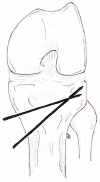Lateral hinge fracture in medial opening wedge high tibial osteotomy: a narrative review
- PMID: 37395709
- PMCID: PMC10321048
- DOI: 10.1530/EOR-22-0103
Lateral hinge fracture in medial opening wedge high tibial osteotomy: a narrative review
Abstract
Lateral hinge fractures (LHF) are one of the most common complications of medial opening wedge high tibial osteotomy (MOWHTO), and are the leading cause of construct instability displacement, non-union, and varus recurrence after this procedure. To date, Takeuchi's classification is the most popular classification to describe this complication, and it can help surgeons to make intra and postoperative decisions. Opening medial gap width is the most recognized factor related to LHF occurrence. Recognizing the implications of LHF in patients' clinical and radiographic results has led many authors to propose surgical tips and the use of osteosynthesis materials such as K-wires and screws for its prevention, which should be considered when identifying risk factors for LHF during preoperative planning. The evidence for determining the optimal management of LHF is scarce and mostly supported by experts' opinions and recommendations; therefore, studies are still needed to identify the most appropriate behavior when dealing with such a complication.
Keywords: knee; lateral hinge fractures; medial opening wedge high tibial osteotomy.
Conflict of interest statement
The authors declare that there is no conflict of interest that could be perceivedas prejudicing the impartiality of the research reported.
Figures



References
-
- Noyes FR Goebel SX & West J. Opening wedge tibial osteotomy: the 3-triangle method to correct axial alignment and tibial slope. American Journal of Sports Medicine 200533378–387. (10.1177/0363546504269034) [published correction appears in American Journal of Sports Medicine 200634 1537. (10.1177/036354650603400919)]. - DOI - DOI - PubMed
Publication types
LinkOut - more resources
Full Text Sources
Miscellaneous

